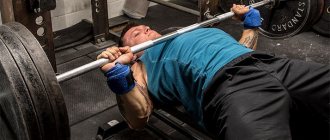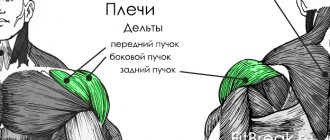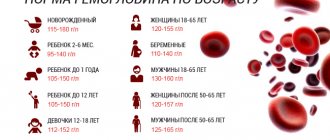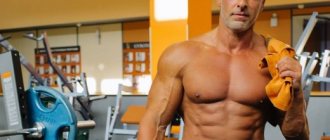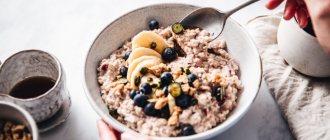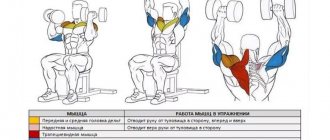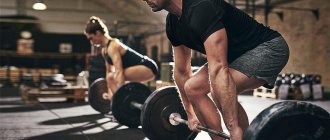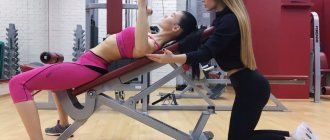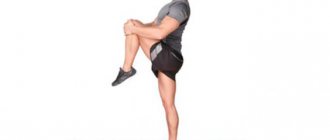04.12.2021
| no comments
No strength training program can be effective without at least one leg workout per week. Even the simplest everyday movements, such as walking and climbing stairs, involve the leg muscles. This means that incorporating leg exercises into your workout routine is a must. I’ll tell you a little secret: if you train your legs well on a regular basis, then as a result, other muscle groups will also receive a muscular and hormonal response.
When it comes to developing an effective leg workout, most beginners opt for light machine exercises or skip leg day altogether. With this attitude, you will also remain the owner of matches instead of powerful and sculpted legs. Basic lower body movements—squats, leg presses, lunges—should make up the majority of your workout. These movements inherently focus on the main muscle groups of the legs: the buttocks and thighs. Let's move on to look at the anatomy of the legs.
Anatomy of leg muscles
The leg muscles are considered one of the largest muscle groups in humans. That is why you should not forget to train them. The legs are divided into 4 main zones:
- The front of the thigh (quadriceps) straightens the leg at the knee;
- The back of the thigh (biceps femoris) extends the hip joint and flexes the leg at the knee;
- The pelvic region (gluteal muscles) extends and rotates the thigh outward, and also straightens and fixes the body;
- The lower leg muscles (gastrocnemius and soleus) flex, extend, and rotate the foot.
Below we will consider each of the zones in detail.
Front thigh
The quadriceps are made up of 4 heads:
- The muscle lateralis is located on the outside of the thigh. This is the largest of the heads. It extends from the top of the femur to the kneecap;
- The medial is the teardrop-shaped muscle of the inner thigh, which is attached along the thigh down to the inner border of the patella;
- The rectus muscle is attached to the kneecap. Of the quadriceps muscles, it has the least effect on knee extension;
- The intermedius is located in the front of the femur between the lateral and medial muscles of the thigh.
These four heads at the front of the thigh are the primary extensors (help to straighten the leg) of the knee.
Posterior thigh
The biceps femoris is located at the back of the thigh and consists of two heads
- Long;
- Short.
Their main task is to bend the legs at the knees, as well as straighten the torso.
Muscles of the Pelvis
The gluteal muscle consists of three paired regions:
- Large muscle;
- Average;
- Small.
It has been proven that the buttocks are the largest muscle in the human body. And this is deserved, because their function is to hold the torso in an upright position, as well as to extend the hip joint.
Calf muscles
The calf muscles are important for the movement of the ankle, foot and toes. They consist of:
- The gastrocnemius, in turn, consists of two heads, medial and lateral;
- Soleus.
They are responsible for walking, running and jumping.
How to train your legs correctly
You need to take leg training with complete seriousness and dedication. Below I want to tell you about the main aspects when training legs.
- Basic exercises . We give priority to heavy multi-joint exercises. These include: various squats, leg presses, lunges, deadlifts (deadlifts, sumo), bends with a barbell. By including these exercises in your training, you can achieve good muscle growth;
- Diversity. Remember that our body is good at adapting to the same type of stress. Therefore, he must be constantly surprised. Do not use the same weights and exercises for a long time. With each workout, progress a little, reduce the rest time between sets, increase the weight, the number of repetitions, change the exercises. Alternate strength and endurance training;
- Warm up for everything. I will not stop repeating that any physical activity must begin with a quality warm-up. The body must be warmed up before strength training to prevent injury. Take at least 10-15 minutes at the beginning of your workout. Start with the whole body, then specifically and thoroughly stretch the muscle group that you will work today;
- Stretching . To speed up the recovery of muscle fibers and improve strength results, stretch at the end of your workout;
- Correct technique . Perhaps one of the most important factors when training any muscle groups. If you do not have sufficient experience in any exercise, do not be lazy, study the technique yourself or with an experienced trainer, both theoretically and practically. Correct technique will significantly reduce the chances of injury and increase the effectiveness of training;
- Reasonable weights . You should not chase huge weights, unless, of course, you are a professional athlete. Choose a weight at which you can perform the exercise technically and without harm to your health;
- Avoid overtraining . There must be moderation everywhere. Don't skip training. For a bodybuilding enthusiast, one (maximum two) quality workout per week is enough.
Basic principles
Leg muscle training should begin with basic exercises. If you start training based on an isolated principle, then in the future you will not be able to master basic movements, which will reduce the effectiveness of training as a whole. Some beginners do this, after which disappointment sets in and, as a result, they quit training. Before starting the training process, it makes sense to start performing basic movements with a minimum load, as a warm-up before the main basic work.
When working with a maximum load, it is advisable to wear an athletic belt, otherwise you can overload your back muscles. In addition, it is advisable to protect the knee joints with bandages, since they experience serious stress. It is realistic to train your legs with an optimal load, so choosing the maximum weight is not recommended.
Before starting training, it is advisable to familiarize yourself with the technique of performing movements. As a rule, it will take weeks, or even months, to perfectly master the technique of performing movements. Under no circumstances should such an approach to the training process be ignored. The final result directly depends on the technique of movement. In addition, during this initial period you should not take risks and use large masses of sports equipment. Weight gain should be smooth and deliberate.
Leg training program
It is advisable to dedicate a full training day to your legs, because training them requires quite a lot of energy and strength. If you don’t have the opportunity to set aside a separate day, then combine your legs with some small muscle group (arms, shoulders). But start your workout with leg exercises. From personal experience I will say that when I trained my arms and legs and started training with my arms, after them I had no desire to move on to training my legs. Yes, this is the reality, well, our people don’t like to train their legs, but in vain! This needs to be corrected, friends, and I will try to help you with this.
Program objectives
- Gaining muscle mass:
- Strengthening ligaments;
- Studying exercise techniques.
Characteristic
- Warm up 10-15 minutes;
- Training 45-70 minutes;
- from 8 to 15 repetitions per 1 approach;
- from 3 to 4 approaches in one exercise;
- Rest no more than three minutes between sets.
Workout #1
- Warm up. Cardio + warming up the knee and ankle joints;
- Squats with a barbell on the shoulders, one warm-up set with light weights + 4 sets of 8-12 repetitions;
- Bench leg press in a machine with feet slightly wider than shoulder-width apart, 3 sets of 12-15 repetitions;
- Romanian deadlift 1 warm-up + 3 sets of 10-12 reps;
- Lying leg curls in the machine 3 sets of 12-15 repetitions;
- Raising your toes while sitting in a machine, 3-4 sets of 15-20 repetitions;
- Stretching.
Workout #2
- Warm-up;
- Hack squats, warm-up + 3 sets of 12-15;
- Lunges with a barbell in motion 2 sets of 30-40 steps;
- Leg extension while sitting in a machine, 3 sets of 12-15;
- Bends with a barbell on the shoulders 3 to 10-12;
- Standing leg curl 3 to 10;
- Toe press in the calf machine 3-4 to 12-15;
- Stretching.
Features of nutrition during training for weight gain
Nutrition plays a significant role in the quality and speed of weight gain. The nutrition plan should be selected individually, do not use a nutrition plan that is not made for you, since the characteristics of the body and its metabolism can vary greatly: for some people gaining weight is easy, for others it can be very difficult. However, there are several useful recommendations that are common to all:
- The most important thing is the accurate calculation of calories. Each meal should be written down by calorie content and BJU (proteins, fats, carbohydrates), and at the end of the day you should get the daily calorie intake for you. That is, food needs to be weighed and the result recorded. The most convenient way to do this is using applications for your phone or PC. These calorie counters will help you calculate the norm for you and allow you to conveniently keep track of each meal.
- You need to include more healthy slow carbohydrates in your diet. Many people focus on protein, but its breakdown in the body is an energy-consuming and long process, so a person loses weight by consuming large amounts of protein. Carbohydrates are digested more easily, which leads to weight gain.
- Some people prefer to eat small meals and very often - up to 6 times a day. This is not necessary unless you are a competitive athlete. 4-5 times will be more than enough.
- With a high-carbohydrate diet, you are likely to gain fat mass as well. But it can be removed in the future on a high-protein diet. Trying to immediately gain weight and “dry” the body is always stressful for the body, given that training is hard and consumes a lot of energy.
In bodybuilding, building mass or “drying” the body should not be carried out for a long time, this is too much stress for the body. It is necessary to take breaks and practice in a softer mode. During the mass-gaining process, provide your body with a sufficient amount of vitamins (you can take ready-made complexes), vegetables, fruits, get a good night's sleep and be sure to rest and recover after working out in the gym.
Recommendations for creating a program
There are three main leg training options that serve different purposes. For best efficiency, they should be alternated.
For gaining muscle mass:
- one workout per week is enough;
- 3-4 sets per exercise, from 8 to 15 repetitions per set;
- rest between approaches no more than 2-3 minutes;
- projectile weight 60-80% of 1RM (one repetition maximum);
- preference for multi-joint exercises;
- number of exercises: quadriceps 3-4, hamstrings 3.
To increase strength
- 1 workout per week;
- number of approaches from 3 to 6;
- working weight 80-100% of 1RM;
- number of repetitions from 1 to 5;
- rest between approaches can be up to 6 minutes;
- Only basic exercises are used;
- the number of exercises is identical when gaining weight.
To increase strength endurance
- 1-2 workouts per week;
- 3-4 approaches per exercise;
- number of exercises: quadriceps up to 5, hamstrings up to 4;
- rep range from 15 to 30;
- projectile weight 50-70% of 1RM;
- rest should not be more than a minute;
- Both basic and isolated exercises are used.
Regarding weight loss
When training your lower body, remember that exercises for losing weight on your legs and thighs, no matter what your trainer tells you. Losing weight in legs occurs due to the combination of several factors:
- Global fat burning.
- Toning “flabby muscles”.
It is due to this that the very effect of exercise for losing weight on legs is manifested. In fact, the legs do not lose weight, it’s just that when pulled up, the muscles are in better tone, which means they don’t sag so much from the attachment point.
If your goal is to exercise to lose weight in your legs, follow a few training principles:
- Training in pumping mode. High reps, low weights.
- Progress solely through increasing the number of repetitions. Any increase in weight threatens muscle hypertrophy, which will lead to their increase.
- Focus on cardio-oriented exercises, they burn fat much more effectively, which allows you to quickly get ideal, slender legs.
If you have already pumped up your legs, you should reduce the weight as much as possible and work in aerobic exercise mode in basic exercises. That is, instead of a 40 kg barbell for 20 repetitions, use a 20 kg barbell and a number of repetitions over 50. This will cause catabolism in red muscle tissue and create conditions for myofibrillar hypertrophy of white fibers, which are much smaller than red ones.
Recipes for healthy eating
Cannelloni with ricotta and spinach
- 9.9 g Protein
- 5.3 g Fat
- 12.1 g Carbohydrates
- 141.2 kcal
40-50 min.
- #second course
- #dietary
- #baking
- #cream cheese
- #low calorie
- #dinner
- #vegetable oil
- #sour cream
- #spices
- #dinner
- #spinach
Other recipes
Basic leg exercises in the gym
Basic multi-joint exercises are designed to stimulate muscle growth and strength in several muscle groups at once, which in turn gives excellent results. Below I will give the top 5 effective leg exercises that I use in my workouts.
Squats with a barbell on your shoulders
Barbell squats are one of the best exercises for pumping up your legs. I recommend including them in every training program. But before performing, carefully study the technique and subtleties of the exercise.
Execution technique
- Place a barbell on your trapezius and stand with your feet shoulder-width apart. Your gaze should be forward, your chest should be out and your shoulders should be pulled back;
- Slowly lower yourself until your thighs are parallel to the floor. Then return to the starting position.
Bench leg press in the simulator
The leg press is a very effective exercise that promotes the growth of quadriceps and gluteal muscles. Depending on the placement of your feet on the platform, you can change the load on the target muscles.
Execution technique
- Sit in a leg press machine with your back and head on the support. Place your feet shoulder-width apart. With this placement of the feet, the load on the muscles is distributed evenly. Your legs should form a 90-degree angle;
- As you exhale, stretch your legs. Pause while straightening;
- Slowly return the platform to the starting position by bending your knees.
Lunges with a barbell or dumbbells
There are many types of lunges: walking, side, standing, back, forward. You can choose those that are more convenient for you to do. Two important rules when performing the exercise: keep your back straight and bend your leg 90 degrees.
Execution technique
- Take the selected projectile;
- As you inhale, lower yourself, forming a right angle at the knee;
- As you exhale, using your legs, return to the starting position.
Hack squats
The exercise can be performed with a barbell or on a machine. I prefer working in a simulator.
Execution technique
- Sit in the machine, your back should be carefully pressed against the backrest;
- As you inhale, we lower ourselves until a right angle is formed in our legs;
- As you exhale, using the strength of your leg muscles, return to the starting position.
Romanian deadlift
The Romanian deadlift perfectly stretches and works the hamstrings, glutes, and lower back.
Execution technique
- Hold a barbell or one dumbbell in each hand. Keep your back straight and look straight throughout the exercise;
- Begin to lean forward, lowering the apparatus towards the ground, slightly bending your knees. Let the weight follow the line of your legs and lower yourself until you feel a good stretch in the back of your thighs;
- Pause for 1-2 seconds and then push your hips forward to stand, letting your glutes control the movement.
Standing calf raise with dumbbells or barbell
Standing calf raises are the main exercise for training the calf muscles. When sitting up on your toes, the load falls on the soleus muscle, which is located under the calf. Therefore, in order to fully develop the muscles of the lower leg, perform the exercise in different variations.
Execution technique
- Take dumbbells in your hands or place the bar on your back;
- Stand with your feet on a low platform (as in the picture);
- Fix the body in a straight position;
- Inhaling air, begin to slowly lower your heels below the level of the platform until you feel a sufficient stretch in the calf muscles;
- As you exhale, with a powerful movement, rise onto your toes;
- Hold the peak contraction for one to two seconds;
- Slowly return to the starting position.
What exercises to do for the inner thigh
Here are located the thin, long, short and magnus adductor muscles, as well as the pectineus muscle. They all adduct the hip and participate in its flexion.
Adduction of legs
EMG evaluation of hip adduction exercises for soccer players: implications for exercise selection in prevention and treatment of groin injuries can be performed using a crossover or resistance band hooked to a stand.
Place the crossover mount on your right ankle and stand one step away from the lower block with your right side facing it. Raise your leg slightly to the side. Overcoming the resistance of the crossover, bring your right leg towards your left, take it back and repeat. When you finish the set, perform on the other leg. Now the mount will be on your left leg and you will stand with your left side to the block.
If performing with a resistance band, hook the band to the stand at shin level and place the loose loop around your ankle. Otherwise, the movement is the same as in the crossover.
Copenhagen ghosts
This exerciseEMG evaluation of hip adduction exercises for soccer players: implications for exercise selection in prevention and treatment of groin injuries can be performed with a partner, on loops, a bar, or a bench. Get into a side plank position on your elbow with your top ankle elevated or tucked into a loop. Or ask your partner to hold your thigh and ankle.
Bring your lower leg towards your upper leg and lower it back down. If you do it on a bar, in loops or with a partner, you can do it straight; if you do it on a bench or box, you can do it with the knee bent.
Information on the simulator
Simple and effectiveEMG evaluation of hip adduction exercises for soccer players: implications for exercise selection in prevention and treatment of groin injuries option for indoor training. Sit on the exercise machine, press your lower back to the chair, grab the handles. Bring your legs together and spread them back.
